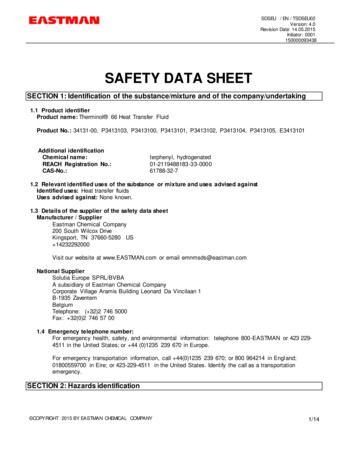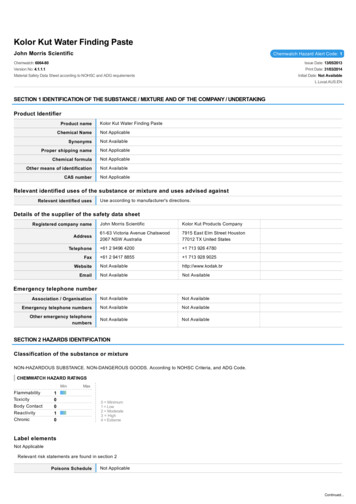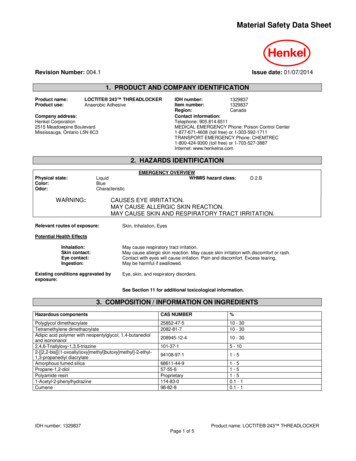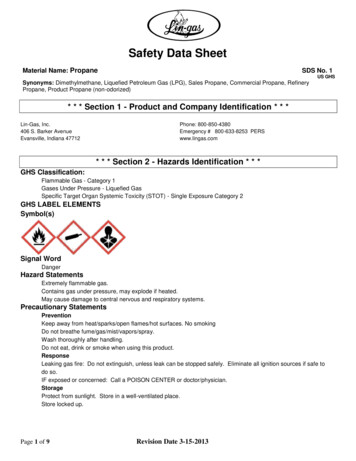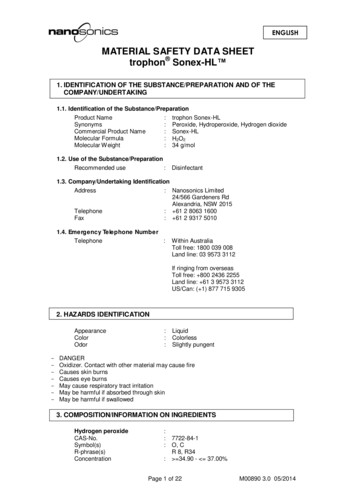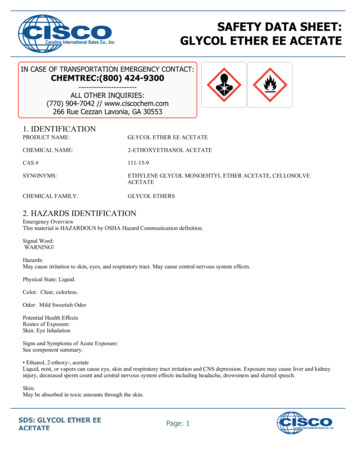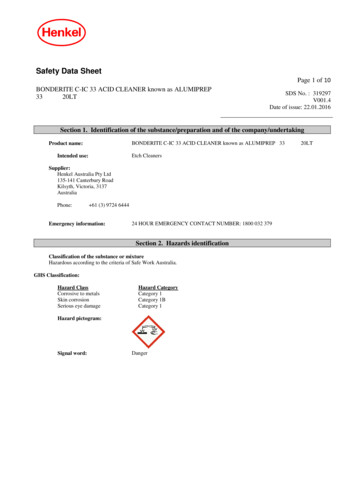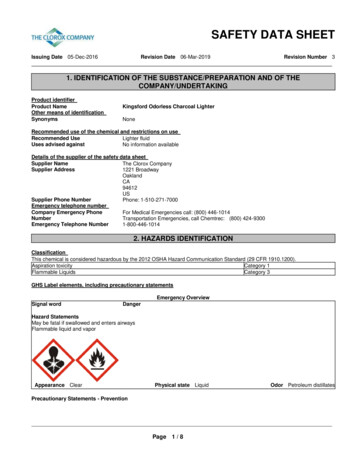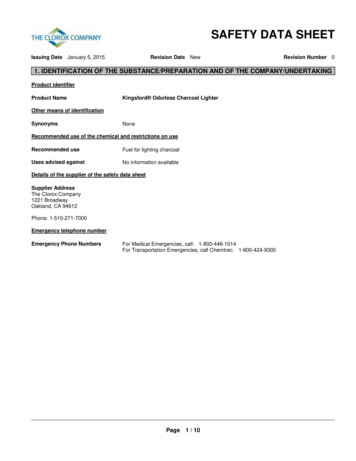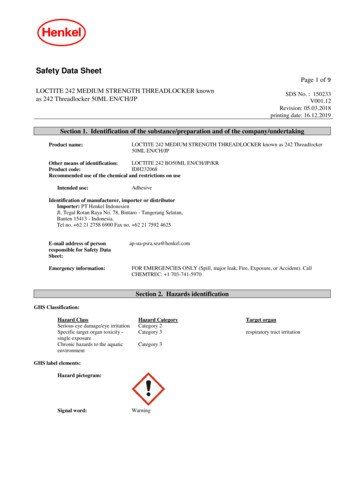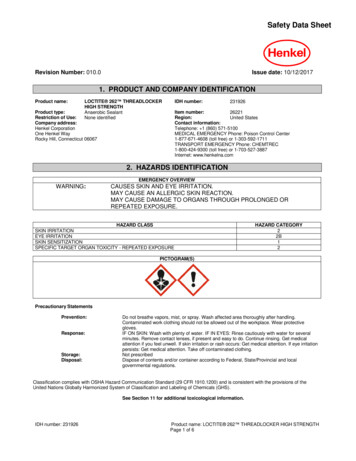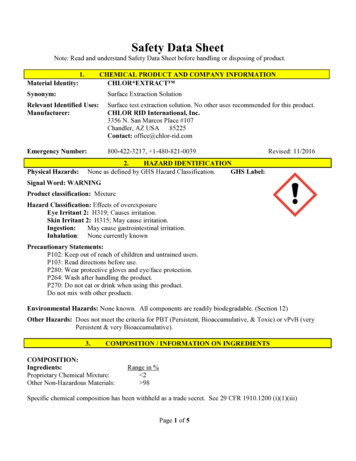
Transcription
Safety Data SheetNote: Read and understand Safety Data Sheet before handling or disposing of product.1.CHEMICAL PRODUCT AND COMPANY INFORMATIONCHLOR*EXTRACT Material Identity:Synonym:Surface Extraction SolutionRelevant Identified Uses:Manufacturer:Surface test extraction solution. No other uses recommended for this product.CHLOR RID International, Inc.3356 N. San Marcos Place #107Chandler, AZ USA85225Contact: office@chlor-rid.comEmergency Number:800-422-3217, 1-480-821-0039Physical Hazards:Revised: 11/20162.HAZARD IDENTIFICATIONNone as defined by GHS Hazard Classification.GHS Label:Signal Word: WARNINGProduct classification: MixtureHazard Classification: Effects of overexposureEye Irritant 2: H319; Causes irritation.Skin Irritant 2: H315; May cause irritation.Ingestion:May cause gastrointestinal irritation.Inhalation: None currently knownPrecautionary Statements:P102: Keep out of reach of children and untrained users.P103: Read directions before use.P280: Wear protective gloves and eye/face protection.P264: Wash after handling the product.P270: Do not eat or drink when using this product.Do not mix with other products.Environmental Hazards: None known. All components are readily biodegradable. (Section 12)Other Hazards: Does not meet the criteria for PBT (Persistent, Bioaccumulative, & Toxic) or vPvB (veryPersistent & very Bioaccumulative).3.COMPOSITION / INFORMATION ON INGREDIENTSCOMPOSITION:Ingredients:Proprietary Chemical Mixture:Other Non-Hazardous Materials:Range in % 2 98Specific chemical composition has been withheld as a trade secret. See 29 CFR 1910.1200 (i)(1)(iii)Page 1 of 5
4.FIRST AID MEASURESEyes:P305 P351: Flush with plenty of water, occasionally lifting upper and lower eyelids. P338:Remove contact lenses. P313: Contact physician if irritation persists.Skin:P303 P353: Flush effected area with plenty of water. P362: wash contaminated clothing beforereuse.Ingestion:P301 P330 P331: If ingested, wash out mouth with plenty of water. Do not induce vomitingunless directed by medical advice. P313: Get medical attention. Do not give anything by mouthto an unconscious person.Inhalation:P304 P340: Remove victim to fresh air and keep at rest in position comfortable forbreathing. P313: Get medical attention if symptoms occur.5.FIRE-FIGHTING MEASURESFlash Point:Does not flashExtinguishing Media:Flammability Limits:Explosive Hazards:Any appropriate media for local circumstances and surrounding media, generallywater.N/ANone KnownFirefighting Instructions:Wear self-contained breathing apparatus (SCBA) and protective suit.Unusual Fire &Explosive Hazards:Hazardous By-Products:Prolonged contact with certain metals may generate minor amounts of hydrogengas which can be diminished by quenching with large amounts of water.None KnownNational Fire Protection Hazard Ratings- NFPA(R)1 Health Hazard- Slight0 Flammability- None0 Reactivity - Minimal6.ACCIDENTAL RELEASE MEASURESProcedure in case of accidental release, breakage or leakage: INFOTRAC 800-535-5053Personal precautions: Wear appropriate protective clothing and/or equipment during cleanup. (Section 8)Environmental precautions and cleanup methods: Dilute with water, or isolate material and neutralize withlime or soda ash, or a suitable non-combustible absorbent (sand, earth, vermiculite, diatomaceous earth).Remove contaminated absorbent. Flush spill area with water.Reference to other sections: Section 8.Comply with local, state, and federal and international regulations for waste disposal. If permissible, flush toindustrial drain.Page 2 of 5
7.HANDLING AND STORAGEPrecautions for safe handling: Minimize spillage. Use appropriate personal protective equipment (Section 8).Avoid contact with eyes, skin, and clothing. P264: Workers should wash hands before eating, drinking, orsmoking.Conditions for safe storage, including incompatibilities: P234: Keep in the original container or suitablealternative. P233: Keep containers sealed. Keep containers in a well-ventilated area. Keep container away fromdirect sunlight. Containers must be resealed after use and kept upright. Do not store in unlabeled containers.Incompatible materials: Keep away from strong alkaline materials.Storage temperatures: In accordance with local regulations. P233: Keep lids tightly closed and away fromheat. Store above 32F (0 C).Specific end uses: See relevant identified use in Section 1. Request Directions for use and technical data.8.EXPOSURE CONTROLS/ PERSONAL PROTECTIONExposure & engineering controls: S51: Use in ventilated areas.Protective Equipment:Eye/Face Protection:Skin Protection:P280: Wear safety glasses with side shields.Personal protective equipment should be selected based on the task beingperformed and risks involved and approved by a specialist before use.Respiratory Protection: Properly fitted air purifying or air fed respirator complying with an approvedstandard if risk assessment indicates this is necessary. Respirator should beselected based on known or anticipated exposure level, the hazards of theproduct and the safe working limits of the respirator.Hand Protection:Material: Rubber or latex gloves.Protective Clothing Pictograms:Exposure Limit for Total Product: 20 mg/m3 TWA.9.Appearance:Odor:Odor Threshold:Oxidizing Properties:Boiling Point:Specific Gravity:pH:Vapor Pressure:Vapor Density:VOC Content:Flash Point:Upper/LowerFlammability:PHYSICAL AND CHEMICAL PROPERTIESClear liquidMildly of burnt sugarNone detectedProduct is not oxidizing100 C (approximately as water)1.01( /- 0.1)3.5 ( /- 0.3)Vapor is waterVapor is waterNon-detectableNon-flammable.Non-flammablePage 3 of 5
Solubility:Partial losive properties:In water, complete miscibleFor n-octanol/water, no test data available.Non-flammable0.98 cPNone10.STABILITY AND REACTIVITYReactivity:Chemical stability:Product is stable under normal conditions of use and storage.Hazardous decomposition will not occur under normal conditionsof use and storage at normal ambient temperatures.Conditions to avoid:Do not mix with other chemicals.Hazardous polymerization:Will not occurHazardous decomposition products: Does not decompose when used as intended.Storage:Store out of direct contact with sunlight.Do not use inconsistent with relevant identified and intended use.11.TOXICOLOGICAL INFORMATIONNo toxicology data is available for this product.Carcinogenicity: None of the components present in concentrations equal to or greater than 0.1% are listed ---------X-12.ECOLOGICAL INFORMATIONToxicity:No information available.Persistence and Degradability:No data available.Environmental effects: Readily biodegradable. No phosphates. Low or non-detectable bioaccumulation.Ecotoxicological information:No information available.Bioaccumalative potential:No information available.Mobility in soil:No data available.Results of PBT and vPvB assessment: Does not meet the criteria for PBT (Persistent, Bioaccumulative, &Toxic) or vPvB (very Persistent and very Bioaccumulative)Other adverse effects:None known.13.DISPOSAL INFORMATIONP501: Comply with local, state, federal and international regulations. If permissible, flush to drain. Otherwisedrain to effluent remediation facility. Neutralize with lime or soda ash, if required, then flush with water.Caution: Misuse of empty containers can be hazardous. Empty containers should not be reused. Do not exposeto open flame or heat. Keep containers closed with caps available.Page 4 of 5
14.TRANSPORT INFORMATIONShipping Classification: Specify as: Item No. 48580 – Sub 3 – Class 55UN Number:Not listed, neither for this mixture nor for substances therein.UN Regulatory Information:DOT Classification:Not regulated.TDG Classification:Not regulated.IMDG Class:Not regulated.IATA-DGR Class:Not regulated15.REGULATORY INFORMATIONReportable Quantity (RQ): No calculable reportable quantity for this product.CERCLA (Superfund) reportable quantity: NoneTSCA Inventory Status: This product is not listed and is exempt from the TSCA Chemical Substances Inventory.SARA Title III (Section 302/304): Nonhazardous.SARA 313: No ingredients listed. Product does not contain nor is manufactured with ozone depleting substances.CA Prop 675: No known substances known to the State of California to cause cancer, birth defect, or reproductiveharm.Canada:WHIMIS Classification D2B.16.TOTHER INFORMATIONSupplemental classification information not included in Section 3, or other Sections:S 24 Avoid contact with skinS 25 Avoid contact with eyesIn accordance with Regulation (EC) 1907/2006 (REACH), and with changes made to comply with Regulation(EU) 453/2010, Annex II.It is the responsibility of the buyer to maintain a safe workplace for the user. Personal protective rating to besupplied by user depending on use condition. The user should consider the health safety information containedherein as a guide and should take these precautions required in an individual operation to instruct employeesand develop protective work procedures for a safe environment.The information contained herein is, to the best of our knowledge, accurate based on data available at the timeof publication. The company accepts no liability for damages incurred.Nothing herein is to be construed as a warranty, expressed or implied. It is the responsibility of the user todetermine the applicability of the information herein and suitability for its own particular purpose.CHLOR RID International Inc800-422-32173356 N. San Marcos Place #107480-821-0039Page 5 of 5Chandler, AZ 85225 USA480-821-0364 fax
Page 1/3MATERIAL SAFETY DATA SHEET1. Identification of the product and of the companyIdentification of the product Catalogue No.:201SCProduct name:KITAGAWA GAS DETECTOR TUBECHLORIDE ION 201SCManufacture/supplier identificationCompany:KOMYO RIKAGAKU KOGYO K.K.1-8-28 SHIMONOGE. TAKATSU-KU. KAWASAKI-CITY. KANAGAWA 213-0006. JAPANTEL 81(0)44-833-8911FAX 81(0)44-833-2672Distributor IdentificationCompany:KITAGAWA AMERICA, LLC200 WANAQUE AVENUE, SUITE 204, POMPTON LAKES, NEW JERSEY 07442, USATEL 973-616-5410TEL 973-865-3407FAX 973-616-54202. Chemical identification of ingredientsDetector tube:Inert porous carrier material impregnated with Silver chromate and Potassium chromate sealed in a glasstube.CAS NUMBERINGREDIENTSmg/Tube%SYMBOLS7784-01-2Silver chromate 0.1 0.1Ag2CrO4K2CrO47789-00-6Potassium chromate2.80.3Hazardous information of ingredientsExposure LimitShort-term:N/A- As impregnated on silica gel.Long-term:N/A- As impregnated on silica gel.In our experience, there is no release of these chemicals from the glass tube in normal use.3. Hazards identificationHazards identification:Glass hazard4. First aid measures (in the case of contact with the contents of a broken tube.)Skin contact:Wash affected area with copious amount of water.Eye contact:Wash eyes immediately with copious amount of water or normal saline solutionEnsure lift eyelids and rinse for at least 15 min. Seek medical attention.Ingestion:Seek medical attention immediately.MSDS No. KE281 Ver.2 Date: 2010/8/20
Page 2/35. Fire fighting measuresFlash point:Non-combustibleExtinguishing media:All known extinguishants can be used.Special fire fighting Procedures:NoneUnusual fire & Explosion hazards:Negligible fire hazard when exposed to heat or flame.6. Accidental release measuresPersonal protection:Do not pick up broken glass with bare hands if the tube is broken. Cover withinert absorbent such as vermiculite. Sweep up and contain for waste disposal.7. Handling and storageHandling & use:Ensure the instructions for use are followed. Safety glasses and gloves should beworn to prevent injury from splintering glass.Storage:Keep away from direct sunlight and store at 25 degree C or lower.8. Exposure control/personal protectionRespiratory protection:Not applicableVentilation:Not applicableOther protective equipment:Safety glasses and gloves9. Physical/Chemical propertiesAppearance:Yellow and Brown solid layers sealed in a glass tube.Boiling point:Not applicableMelting point:Not applicableSpecific gravity (H2O 1):Not applicableEvaporation rate (BuOAc 1):Not applicableSolubility in water:Not applicableVapour pressure:Not applicableVapour density:Not applicable10. Stability and ReactivityStability:Stable at under ambient temperatures and pressures.Incompatibilities:Not applicableHazardous decomposition products:NoneHazardous polymerization:NoneMSDS No. KE281 Ver.2 Date: 2010/8/20
Page 3/311. Toxicological informationGeneral:In our experience this products is not harmful to health when correctlyused/handled.Skin contact:Contents may be irritating to the skin if the tube broken.Eye contact:Contents may be irritating to the eyes if the tube broken.Ingestion:Glass hazard12. Ecological informationGeneral:Do not allow to enter drinking water supplies.13. Disposal considerationsGeneral:Ensure the tubes are open at both end. Submerge in Water. Neutralize water ifnecessary and dispose of as aqueous waste. The glass tubes can then be disposedof as inert "sharps".14. Transport informationGeneral:This product does not pose significant risk to health, safety or property.15. Regulatory informationGeneral:Not classified hazardous under CHIP2 Regulations as this product consists of asealed glass tube containing a small amount of chemicals impregnated ontoSilica sand.16. Other informationDetails given in this document are believed to be correct at the time of going to press. While proper care hasbeen taken in the preparation of this document, but we cannot guarantee its accuracy or completeness,therefore we disclaim any liability for injury or damage when the product is used for other purposes than itis intended.MSDS No. KE281 Ver.2 Date: 2010/8/20
MSDSMATERIAL SAFETY DATA SHEETP.O. Box 329 - 802 Washington Avenue Chestertown, MD 21620 - USATELEPHONE # FOR INFORMATION 410 778-310024 HOUR EMERGENCY NUMBER (CHEM-TEL): USA, Canada, Puerto Rico 800-255-3924;Outside North American Continent 813-248-0585 (call Collect)1. Product IdentificationManufactured By: LaMotte Company802 Washington AvenueProduct Code: 2996Product Description: Nitrate/Nitrite Test StripsChestertown, MD 216202. Composition/Information On IngredientsHazard CAS#/Name%N/ADyes 1N/ABuffers, surfactants 1N/APolymers, binders 1N/AOrganic acid 1N/Atrace metalsPEL 0.1Test strips measure Nitrate and Nitrite in water.Test strips do not contain hazardous ingredients in amounts that exceed 0.l%.All other ingredients are proprietary.1TLV
Product Code: 2996Product Description: Nitrate/Nitrite Test Strips3. Hazards OverviewPrimary Route Of Entry: IngestionMay be harmful if swallowed.HMIS HazardScale: 4 Extreme, 3 High, 2 Moderate, 1 Slight, 0 LeastHealth: 0Flammability: 0Reactivity: 0Carcinogenicity: None:Other Health Related Comments:4. First Aid MeasuresEye Contact: Flush with water.Skin Contact: Flush with water. Wash with soap and water.Ingestion: Consult a physician.Inhalation: N/A5. Fire Fighting MeasuresFlash Point (Method Used):LEL: N/AN/AExtinguishing Media:Water spraySpecial Fire Fighting Procedures:N/AUnusual Fire & Explosion Hazard:N/A6. Accidental Release MeasuresSweep up and discard to trash.2UEL: N/A
Product Code: 2996Product Description: Nitrate/Nitrite Test Strips7. Handling & StorageKeep container tightly closed when not in use. Store in cool, dry place out of direct sunlight.8. Exposure Controls/Personal ProtectionVentilationNormalProtection When HandlingN/AWork/Hygenic Practices:N/A9. Physical & Chemical PropertiesAppearance:Solubility In Water:Odor:pH:White plastic strip w/ colored paper padsInsolubleNoneN/AVapor Density:Vapor Pressure:Boiling Point:Melting Point:10. Stability & ReactivityStable:YesConditions To Avoid:Heat, Light, Moisture, air.Incompatibility (Materials To Avoid):N/AHazardous Decomposition Products:N/A3N/AN/AN/AN/A
Product Code: 2996Product Description: Nitrate/Nitrite Test Strips11. Toxicological Informationnon-toxicTarget Organs:N/A12. Ecological InformationInformation not yet available.13. Disposal ConsiderationsDiscard to trash. Dispose of in accordance to federal, state and local regulations.14.QRLabel53Transportation InformationNot Regulated For Transport15. Regulatory InformationChemical Inventory StatusHazardIngredientUSATSCAEuropeEC--- Canada --DSLNDSL4AustraliaJapan
Product Code: 2996Product Description: Nitrate/Nitrite Test StripsFederal, State, & International Regulations--- SARA 302 --IngredientRQTPQ--------- SARA 313 --------ListedChemical Category5CERCLARCRA261.33TSCA8(D)
Product Code: 2996Ingredientproduct 2996as a wholeProduct Description: Nitrate/Nitrite Test Strips--- SARA 311/312 --Hazard CategoriesAcute Chronic Fire Pressure Reactivity-------- Australia ------HazchemPoisonCodeScheduleNoNone AllocatedNoNoNoNo16. Other InformationPrepared By: DMH, Regulatory Affairs DepartmentRevised: 2/11/20096This MSDS IsWHMIS CompliantNone Allocated Yes
Safety Data SheetNote: Read and understand Safety Data Sheet before handling or disposing of product.1.CHEMICAL PRODUCT AND COMPANY INFORMATIONMaterial Identity:Sulfate Reagent (1 milliliter liquid in capped vials)Synonym:UN No. 1564Product Use:Laboratory/test kit reagent. Laboratory chemicals (not for food or food contact)Manufacturer:CHLOR RID International, Inc.3356 N. San Marcos Place #107Chandler AZ 85225Emergency Number:800-422-3217, 480-821-00392.Revised: 6/2016HAZARD IDENTIFICATIONCategory 4Acute toxicity - OralGHS Label:Signal Word: WARNINGHazard Statement:See also Section 4.Precautionary Statements - PreventionWash face, hands and any exposed skin thoroughly after handling. Do not eat, drink or smoke when using this product.Avoid breathing dust/fume/gas/mist/vapors/spray. Use only outdoors or in a well-ventilated area.IF IN EYES: Rinse cautiously with water for several minutes. Remove contact lenses, if present and easy to do. Continuerinsing.IF ON SKIN: Wash with plenty of soap and waterTake off contaminated clothing and wash before reuseIF INHALED: Remove victim to fresh air and keep at rest in a position comfortable for breathingCall a POISON CENTER or doctor/physician if you feel unwellIF SWALLOWED: Call a POISON CENTER or doctor/physician if you feel unwell, Rinse mouthPrecautionary Statements - DisposalDispose of contents/container to an approved waste disposal plant.Other HazardsHarmful to aquatic life with long lasting effectsRead the entire SDS for more thorough evaluation of precautions required.1
3.COMPOSITION / INFORMATION ON INGREDIENTSCAS No9000-01-510326-27-95949-29-1Chemical nameGum arabicBarium chloride dihydrateCitric acid monohydrate4.Weight-%0.4915FIRST AID MEASURESFirst Aid MeasuresGeneral adviceShow this safety data sheet to the doctor in attendance. Do not get in eyes, on skin,or on clothing. Do not breathe dust/fume/gas/mist/vapors/spray.Eye contactIF IN EYES: Rinse cautiously with water for several minutes. Remove contact lenses,if present and easy to do. Continue rinsing. Call a physician immediately.Skin contactWash off immediately with soap and plenty of water for at least 15 minutes. Take offcontaminated clothing and wash before reuse. If symptoms persist, call a physician.InhalationIF INHALED: Remove to fresh air and keep at rest in a position comfortable forbreathing. Call a physician immediately.IngestionInduce vomiting, but only if victim is fully conscious. Call a physician immediately.Never give anything by mouth to an unconscious person.Self-protection of the first aiderUse personal protection recommended in Section 8. Ensure that medical personnelare aware of the material(s) involved, take precautions to protect themselves andprevent spread of contamination.5.FIRE-FIGHTING MEASURES/ EXPLOSIVE HAZARDSSuitable extinguishing mediaUse extinguishing measures that are appropriate to local circumstances and the surrounding environment.Protective equipment and precautions for firefightersAs in any fire, wear self-contained
MATERIAL SAFETY DATA SHEET 1. Identification of the product and of the company Identification of the product Catalogue No.: 201SC Product name: KITAGAWA GAS DETECTOR TUBE CHLORIDE ION 201SC Manufacture/supplier identification Company: KOMYO RIKAGAKU KOGYO K.K. 1-8-28 SHIMONOGE. TAKATSU-KU. KA
